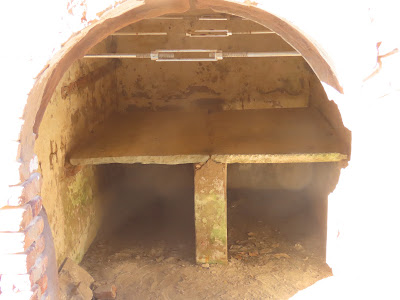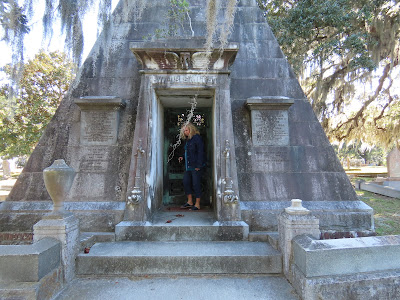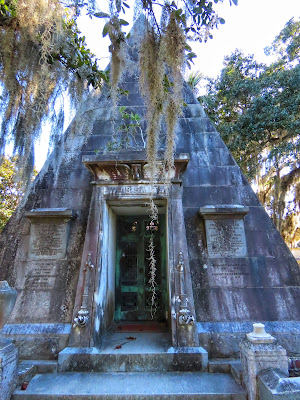We stopped by Magnolia Cemetery last Saturday after a nice lunch downtown at Fleet Landing. It was such a pretty day I thought it would be fun to walk off our big meal at the cemetery.
Joseph took this photo of me at the iconic Smith Pyramid, eternal home to William Burroughs Smith, a wealthy banker who died in 1892.
The pyramid and hundreds of other gravesites and the people interred in them are featured in my 2014 book, "In the Arms of Angels: Magnolia Cemetery- Charleston's Treasure of History, Mystery and Artistry." Check it out as well as my other books for sale on Amazon. My book information is also available at the top of this blog.
On this sunny fall day I also wanted Joseph to see the spot we are purchasing in the mausoleum at Magnolia Cemetery.
I still have a number of monthly payments to make. But once that is accomplished we can have our names inscribed on the outside. Kind of creepy I know, but kind of cool too!
Here are some of the pictures I took as we walked around the venerable150 acre burial grounds. Someone put a tiara on the lovely figure on the tomb of "Little Annie" Aiken who was just shy of 3 years old when she died at 1856 of diphtheria, a bacterial disease that a vaccine today can cure and prevent.
Small items are regularly placed by Little Annie- a very touching tribute.
This is Magnolia Cemetery's Receiving Tomb. William Burroughs Smith, previously mentioned for his grand pyramid, spent 30 months (at least his body did) in here as the huge pyramid mausoleum was being built.
I don't know much about the White mausoleum located in the back of the cemetery along "Mausoleum Row." Its floor has long been broken so that the different levels of shelves can be seen. this of course is where the caskets would be placed. It's curious that no names are inscribed on the white tablet in the back.
It's always interesting to examine up close the Smith Pyramid. Inside can be seen the body of a sculpted female figure that used to be on the mantel above the entrance. No head, just the body, is seen on the floor to the left as you look through the door.
This is the rather hidden gravesite of a family who were very prominent as the owners of Middleton Place, an historic plantation on the Ashley River that today is among the most visited Charleston area attractions.
John inherited Middleton Place in 1914 and he and Hemingway restored it to the glorious state that it is in today. The couple is not in my "In the Arms of Angles" book, but I wish they were.
On the weekends the flags of the Confederacy are not flown here at the Soldiers' Grounds. Thousands of Confederate veterans, including hundreds who died during the Civil War, are interred at this cemetery.
From the back of the cemetery, along the Cooper River, can be seen one of Charleston's several port facilities. One of the massive container ships is docked there.
The birding was good during this visit. A "bowl" of Roseate Spoonbills was on this tree by the front pond before flying to the marsh in the back. I think I spooked them.
This is a Wood Stork, one of my favorite birds in the Lowcountry.
Here we have a Snowy Egret, known for its beauty and yellow "slippers" that you cannot see in this image.
I was not the only photographer shooting birds.
Before we left the Charleston Cemetery Historic District (there are 20 or so different cemeteries in this area near Magnolia Cemetery!) I wanted to show Joseph the spectacular grave site of young Herbert Alonzo Brown.
This is at the Trinity AME Cemetery. Every time I stop here there are new additions! The stagecoach on the little boy’s headstone is one, then there’s the Tiger Woods bobblehead and the Silver Knight of Augsburg. Four-year-old Herbert died in 1983 after being hit by a truck on the highway near Edisto Beach. I tell his story and how his whimsical grave keeps growing in my book, “Stories from the Underground: The Churchyards of Charleston.”
This was a fun day in downtown Charleston then at these fascinating cemeteries.





























No comments:
Post a Comment